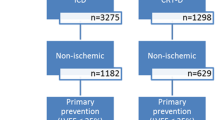Abstract
Background
Implantable cardioverter- defibrillator (ICD) therapy is established for the prevention of sudden cardiac death (SCD) in different entities. However, data from large patient cohorts with electrical heart disease are rare. Therefore, we investigated these patients as well as patients with hypertrophic cardiomyopathy by analyzing registry data from a multi-center ‘real-life’ registry.
Methods
The German Device Registry (DEVICE) is a nationwide, prospective registry with one-year follow-up investigating 5450 patients receiving device implantations in 50 German centers. The present analysis of DEVICE focussed on patients with electrical heart disease or HCM who received an ICD for primary or secondary prevention.
Results
174 patients with HCM and 112 patients with electrical heart disease (long-QT syndrome, Brugada syndrome and arrhythmogenic right ventricular cardiomyopathy) were compared with 5164 other ICD patients. Median follow-up was 17.0 months. Patients in the control group were significantly older. Of note, overall mortality after 1 year was 1.8% in HCM patients, 6.6% in patients with electrical heart disease and 7.3% in the control group. Patients in the control group presented significantly more severe comorbidities. In contrast to HCM patients and the control group where primary prevention was the major indication for ICD implantation, 77.5% of patients with electrical heart disease received an ICD for secondary prevention. The number of surgical revisions was higher in patients with electrical heart disease.
Conclusion
Data from the present registry display a surprisingly high mortality in patients with electrical heart disease equivalent to the control group. A high proportion of patients who received an ICD for secondary prevention may be regarded as a major determinant for these results, while severe comorbidities such as diabetes, hypertension, and renal failure are major determinants for mortality in the control cohort.
Similar content being viewed by others
References
Priori SG, Blomstrom-Lundqvist C, Mazzanti A, Blom N, Borggrefe M, Camm J et al (2015) 2015 ESC Guidelines for the management of patients with ventricular arrhythmias and the prevention of sudden cardiac death: the task force for the management of patients with ventricular arrhythmias and the prevention of sudden cardiac death of the European society of cardiology (ESC) endorsed by: association for european paediatric and congenital cardiology (AEPC). Europace. 17:1601–1687
Moss AJ, Hall WJ, Cannom DS, Daubert JP, Higgins SL, Klein H et al (1996) Improved survival with an implanted defibrillator in patients with coronary disease at high risk for ventricular arrhythmia Multicenter automatic defibrillator implantation trial investigators. N Engl J Med. 335:1933–1940
Moss AJ, Zareba W, Hall WJ, Klein H, Wilber DJ, Cannom DS et al (2002) Prophylactic implantation of a defibrillator in patients with myocardial infarction and reduced ejection fraction. N Engl J Med. 346:877–883
Bardy GH, Lee KL, Mark DB, Poole JE, Packer DL, Boineau R et al (2005) Amiodarone or an implantable cardioverter-defibrillator for congestive heart failure. N Engl J Med. 352:225–237
Kadish A, Dyer A, Daubert JP, Quigg R, Estes NA, Anderson KP et al (2004) Prophylactic defibrillator implantation in patients with nonischemic dilated cardiomyopathy. N Engl J Med. 350:2151–2158
Kobe J, Andresen D, Maier S, Stellbrink C, Kleemann T, Gonska BD et al (2017) Complications and 1-year benefit of cardiac resynchronization therapy in patients over 75 years of age—Insights from the German device registry. Int J Cardiol 228:784–789
D'Ancona G, Safak E, Senges J, Hochadel M, Nguyen VL, Perings C et al (2017) Activation of remote monitoring for cardiac implantable electronic devices: small dog for tall weeds. Clin Res Cardiol 106:833–839
Frommeyer G, Andresen D, Ince H, Maier S, Stellbrink C, Kleemann T et al (2019) Can we rely on Danish? real-world data on patients with nonischemic cardiomyopathy from the German device registry. Heart Vessels 34(7):1196–1202
Frommeyer G, Dechering DG, Zumhagen S, Loher A, Kobe J, Eckardt L et al (2016) Long-term follow-up of subcutaneous ICD systems in patients with hypertrophic cardiomyopathy: a single-center experience. Clin Res Cardiol 105:89–93
Vamos M, Healey JS, Wang J, Connolly SJ, Mabo P, Van Erven L et al (2018) Implantable cardioverter-defibrillator therapy in hypertrophic cardiomyopathy: a simple substudy. Heart rhythm. 15:386–392
Frommeyer G, Dechering DG, Kochhauser S, Bettin M, Kobe J, Eckardt L et al (2016) Long-time "real-life" performance of the subcutaneous ICD in patients with electrical heart disease or idiopathic ventricular fibrillation. J Interventional Cardiac Electrophysiol. 47:185–188
Probst V, Veltmann C, Eckardt L, Meregalli PG, Gaita F, Tan HL et al (2010) Long-term prognosis of patients diagnosed with Brugada syndrome: results from the Finger Brugada syndrome registry. Circulation 121:635–643
Monnig G, Kobe J, Loher A, Wasmer K, Milberg P, Zellerhoff S et al (2012) Role of implantable cardioverter defibrillator therapy in patients with acquired long QT syndrome: a long-term follow-up. Europace 14:396–401
Schuler PK, Haegeli LM, Saguner AM, Wolber T, Tanner FC, Jenni R et al (2012) Predictors of appropriate ICD therapy in patients with arrhythmogenic right ventricular cardiomyopathy: long term experience of a tertiary care center. PLoS ONE 7:e39584
Frommeyer G, Feder S, Bettin M, Debus V, Kobe J, Reinke F et al (2018) Long-term single-center experience of defibrillator therapy in children and adolescents. Int J Cardiol 271:105–108
Willy K, Bettin M, Reinke F, Bogeholz N, Ellermann C, Rath B et al (2019) Feasibility of entirely subcutaneous ICD systems in patients with coronary artery disease. Clin Res Cardiol. https://doi.org/10.1007/s00392-019-01455-5
Author information
Authors and Affiliations
Corresponding author
Ethics declarations
Conflict of interest
All authors declare to have no relevant conflict of interest.
Rights and permissions
About this article
Cite this article
Frommeyer, G., Reinke, F., Andresen, D. et al. Implantable cardioverter defibrillators in patients with electrical heart disease and hypertrophic cardiomyopathy: data from the German device registry. Clin Res Cardiol 109, 508–512 (2020). https://doi.org/10.1007/s00392-019-01532-9
Received:
Accepted:
Published:
Issue Date:
DOI: https://doi.org/10.1007/s00392-019-01532-9




